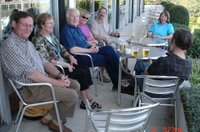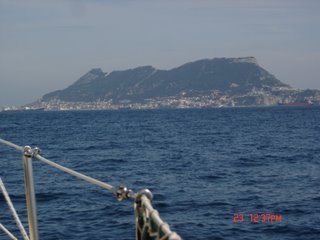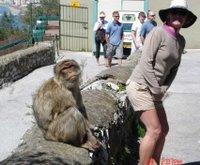Seville to Gibraltar

Remember, photos can be enlarged by clicking on them but remember to choose "Back" to return to this page.
We slipped the slip of Club Nautico Sevilla on March 8th after exactly 100 days in this beautiful city. We were sorry to leave, but it was time to move on. The bridge did open for us at 1730 (the operator was not drunk and managed to get the police to ensure all the traffic had stopped before raising the bridge) and we also made the 1800 lock opening two nm down the river. Anchoring in the Guadilqivir River at the peaceful junction of the canal on the second attempt in a strong tidal current around 1900 watching the freighters pass by for a few hours before darkness set in, finished the day’s traveling.
It was a peaceful night. The noise of the big city was gone - no sirens, construction noise, traffic horns and fumes, neighbours… The first time we had anchored for months.
 Photo: Saying goodbye to our neighbours at the Club Nautico Marina
Photo: Saying goodbye to our neighbours at the Club Nautico Marina .
The next morning we awoke to unforecasted fog that scotched our hopes of making passage down the river with the early tidal current. Nothing to do but sit at anchor for the day reading a book, drinking tea and hoping the following day would be a brighter one - and it was. The plan was to make best use of the tidal current, anchor for 3 - 4 hours in the adverse current then motor downriver again with the tide change as far as we could before dark. As luck would have it - or maybe the current was not as strong as we had anticipated - we kept on plodding the whole 40 nm to Chipiona and tied up in the marina at 1700. Our friends on Roam greeted us and with bottles of wine we celebrated our return to Chipiona.
 The motor down the river was quite uneventful. There was little wind, lots of sun, three freighters passed us giving us lots of room, the shrimp boats were not working, the herons were in their nests and it really was a tranquil trip.
The motor down the river was quite uneventful. There was little wind, lots of sun, three freighters passed us giving us lots of room, the shrimp boats were not working, the herons were in their nests and it really was a tranquil trip.The next week was spent in Chipiona just waiting for the right weather conditions to sail east and commiserating with Roam’s crew who had decided to replace their dying engine to the tune of many euros. On the 14th we “sailed” to Rota, a distance of only 15 nm, a frustrating five hours of motoring into head winds and small waves.
We had actually intended to make Cadiz – another 5 nm, but the thought of battling another two hours made the decision easy. We were very pleasantly surprised by the pretty port and town of Rota. The weather worsened and it was not for another week that we could sail to Barbate (35 nm) and the next day make Gibraltar.
The last 37 nm leg was motored. Tunny (tuna) nets, set two miles offshore, were to be skirted at Zahara just as we had done approaching Rota. Passing Tarifa – the narrowest point in the Straits of Gibraltar that for 300 days of the year has wind speeds of over 30 knots – we observed the limp flags and glassy seas. With the tide and perpetual current into the Mediterranean our SOG "speed over the ground
 " was often above seven knots.
" was often above seven knots.Living in the shadow of The Rock
Photo: approaching "The Rock" 23 March 2006"
.
Gibraltar is a different experience. “Not quite British and definitely not Spanish” is how our guide book correctly puts it. There still exists a slight political friction between Spain and Britain about The Rock – should we give it back? The locals are fluently bilingual with interesting English and Spanish accents. There is also a sizeable permanent Jewish and Muslim population here evidenced by the dress commonly seen around the town and a large mosque out at Europa Point. Many of the shopkeepers are of East Indian descent, so it is a truly multicultural society.
However, it is a tourist destination and the the beet-red (sunburnt) brit tourists arriving four flights daily gorge on fish and chips, brit-beers, duty-free liquor and visit Marks and Spencers to spend. Gibraltar is shabby, expensive (replace dollars with English pounds), and the across-the-runway (border) walk to Spanish La Linea is refreshing. The marina is 150 metres east of the airport runway so we are provided with daily entertainment – especially the seagull clearing exercises before the daily six flights arrive and depart.
 We took the cable car to the top of the Rock on a cloudless day and visited with the Barbary apes (tailless monkeys - macaques) and spent two enjoyable hours walking down, peering into the old barred-off tunnels and gun turrets, observing the snow on the African Atlas Mountains to the south and the Spanish Sierras in the east and imagining the glory days of the Rock. It is quite unforgettable – just like the pictures: picturesque and steeped in history - but only if they would make it tourist friendly instead of the rip-off it actually is - and clean it up a little. Jaded and faded, almost dirty and depressing when off the beaten track.
We took the cable car to the top of the Rock on a cloudless day and visited with the Barbary apes (tailless monkeys - macaques) and spent two enjoyable hours walking down, peering into the old barred-off tunnels and gun turrets, observing the snow on the African Atlas Mountains to the south and the Spanish Sierras in the east and imagining the glory days of the Rock. It is quite unforgettable – just like the pictures: picturesque and steeped in history - but only if they would make it tourist friendly instead of the rip-off it actually is - and clean it up a little. Jaded and faded, almost dirty and depressing when off the beaten track. Terry and Fiona from Roam came to stay for a few days with us and in their rental car we “took to the hills” to visit Ronda, an old city in the mountains built on the sides of a gorge. All the “white cities” in the mountains are very, very pretty – whitewashed houses with red terracotta brick tiled roofs with their donkey-narrow streets hanging on cliff faces. Although we had biked across to Spain several times with no hassels (usually it is a nod and wave through with a mere glance at the passport covers), we were stopped while crossing the border in the car and told that we were illegally entering Spain (our visas had long expired) but they did allow us one day in the end.
Terry and Fiona from Roam came to stay for a few days with us and in their rental car we “took to the hills” to visit Ronda, an old city in the mountains built on the sides of a gorge. All the “white cities” in the mountains are very, very pretty – whitewashed houses with red terracotta brick tiled roofs with their donkey-narrow streets hanging on cliff faces. Although we had biked across to Spain several times with no hassels (usually it is a nod and wave through with a mere glance at the passport covers), we were stopped while crossing the border in the car and told that we were illegally entering Spain (our visas had long expired) but they did allow us one day in the end. Photo: One of the Spanish "white cities" in the mountains north of Gibraltar
Photo: One of the Spanish "white cities" in the mountains north of Gibraltar .
We are staying here in Gib a little longer than anticipated trying to rearrange boat insurance. Our insurance company required an out of water survey (expensive here) after only three years. We have found another company (Pantaenius) that will insure us with our existing survey for the same premium, so there really is little contest. Currently negotiating and finalizing everything before sailing across to Morocco later in the week, we have also managed to delete the top few items from the never-ending job list – a Navtex weather receiver, a new mainsheet, some electrical rewiring, adding shape and waterproofing the sagging bimini, purchasing all the guides and charts we need for the Mediterranean. An expensive stop even though it is a duty-free port..
 Haircut time again (photo thanks to Suleika)
Haircut time again (photo thanks to Suleika).
The marina is $14 CAD per night, quite reasonable considering the location. It is bow-to mooring (commonly called “Med style”) to cram more boats in. It makes getting on and off interesting in the swells that roll through the marina when the high-speed ferries pass. One of the other two marinas is closing soon and is currently building luxury condos overlooking the bay adding to the highrise skyline.
The NZ boat Hullabaloo dropped by for a visit (by car) and to pick up several items we had brought for them from Seville. It was great to see them again. We “happy houred” often with a friendly Swiss couple, Martin and Adriana on yacht Suleika moored next to us. They have a brand new aluminium boat and are ambitiously planning to slowly sail around the world.
 Photo: Ronda - built on the side of a gorge
Photo: Ronda - built on the side of a gorge .
All in all, an interesting stopover, one we would not have missed, but it is off across the Strait to Morocco as soon as the weather cooperates. Smir is the destination primarily to take Chinook out of the EU so we can re-enter (her) avoiding paying VAT (GST, IVA) as it is now 18 months since we entered the European mainland.
Photo below: the mosque at Europa Point
 Click here to return to the HOME PAGE
Click here to return to the HOME PAGE 